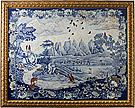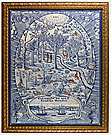Danie MELLOR

These three images explore the interaction between people and their relationships with Country, both Indigenous and non-Indigenous. In many respects, the works tell the story of the challenge of European settlement in this country and of the passage of history and are an overview of ideas that deal with human presence, landscape, architecture and mortality. They acknowledge Indigenous people being here, our legacy and our connection with place and land.
Paradise in the sun is a vision of the new land that could have been imagined in a Rousseauian manner prior to settlement in this country. Based on an illustration by German artist Christopher Switzer for the frontispiece of John Parkinson’s 1629 botanical treatise Paradisi in sole: paradisus terrestris, this image explores the depiction of Western ideas of ‘Eden’, the pristine state of existence, and the emanation of the world from a spiritual source. Welcome to the Lucky Country develops the idea of settler presence, showing a growing urban sprawl and the buildings of a new colony. An Elysian city (of picturesque landscapes and memory) is the final work in the set and shows a group of men preparing for ceremony in spite of the monumental architectural developments surrounding them, which have irrevocably transformed the landscape.
These works all focus, in different ways, on the complexity of our shared history and of our interactions that have been marked by tragedy and sorrow, triumph and success.
Danie Mellor is descended from the Mamu, Ngagen and Ngajan peoples whose Country lies in the Atherton Tablelands of far north Queensland. In unDisclosed, Mellor presents three ornately framed works that explore two major themes—people and the environment. The drawings present images and aspects of the colonised and the colonisers and of the connections between the past and present. They track the transformation of the natural for the sake of the built environment and the detrimental effect this change has had on Indigenous people.
Paradise in the sun 2010 is a translation of the frontispiece of the renowned English botanist and herbalist John Parkinson’s treatise on plants and gardens, Paradisi in sole: paradisus terrestris, published in London in 1629. The original woodcut is a romanticised vision of an imagined landscape. It features Adam and Eve in ‘paradise’, showing different types of gardens—the flower garden, the kitchen garden, and the orchard garden, full of exotic plants, flowers and trees—that could be grown in seventeenth-century England. Two winged cherubs sit in the top corners, symbolising the winds, beside a mysterious Hebrew inscription. The entire scene is outlined in sunlight, ray-bursts around the edges hinting at the imagined glorious and perfect sunny lands. Mellor’s work approximates the original, although the Adam and Eve figures have been replaced by an Aboriginal man and woman standing in the middle ground; looking back with strong curious gazes, at ease, in a bountiful landscape full of native and exotic plants and trees. A clear pure stream flows through the pristine landscape providing essential nourishment for all. Typical of Mellor’s drawings, the image is rendered in blue and white save for the figures of the Indigenous people and the native animals, drawn in full colour. In the lower section of the composition is a vignette in which a landscape is dotted with colonial buildings and two large sailing ships lie at anchor. The image offers a window to the future, of what was to come to these new lands. On the outer edge of the picture is a single row of Swarovski crystals, another signature technique in Mellor’s works. Patches of sepia imitate foxing over the surface of the work to give it a sense of ageing.
Welcome to the Lucky Country 2009 shows the slow change in the landscape, the encroaching colonial civilisation set small against towering mountains. In the lower right-hand corner a human skull surrounded by four hugging koalas provides evidence of the colonial encounter. An Aboriginal family group looks on curiously, an outstretched arm drawing the eye across to the fledgling township in the distance.
An Elysian city (of picturesque landscapes and memory) 2010 refers in Greek mythology to the final resting place of the souls of heroes and the righteous. The work focuses on a group of Aboriginal men who, despite being overshadowed by the heavily built environment that was once their lands, prepare for a ceremony or fight. They are located in a cemetery; the imagery is based on the classical architecture reminiscent of eighteenth- and nineteenth-century European graveyards full of large mausoleums and obelisks appearing as a manifestation of the so-called Enlightenment, and perhaps hinting at early colonial thinking that Aboriginal people were a dying race. The transformation of the landscape is apparent, though the men continue, a testament to the adaptation and resilience of Aboriginal people. Hidden aspects reveal themselves in the light of the full moon; two Aboriginal men guard the men below, using the buildings as vantage points much as they would have used hills or cliffs; a lone kookaburra sits atop the obelisk facing the men as though watching their backs. On the obelisk there is an inscription in the language of the Mamu and Jirrbal, which reads:
MURNYA, GUWUY, GUYNGGAN, NGUNYINY … GAYGA, NGULMURUGA[1]
This translates to ‘Spirit of a dead child, spirit of a dead man, spirit of a dead woman, ghost spirit … nearly dark/twilight’ and carries the weighty meaning of impending death.
The strength of this series of works lies in the subtle political message of Aboriginal people’s resilience in the face of the hardships and constraints imposed on them. Mellor engages and challenges viewers with ‘the complexity of our shared history’ through a visual language rich in symbolism and iconography.[2]
Tina Baum
[1]Danie Mellor, email correspondence with author, 2011.
[2]Mellor, artist statement, see p 3.



